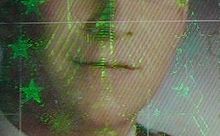Forgery of ID
Forgery of an ID is the criminally motivated manipulation or the total forgery of an ID or authorization certificate for the purpose of deception . Mostly these are official documents such as passports , ID cards and driver's licenses.
Goal setting
The aim of counterfeiting is to thwart the identification of a person and / or to exploit the authorizations of certain persons or to pretend a certain nationality .
With a forged or falsified ID, the ID card holder can simulate access authorization (employee ID), qualification ( driver's license , pilot's license , school leaving certificate , license to practice medicine ), status ( age of majority , diplomatic status ), age or nationality (right of residence). In most cases, documents are ver faking it to change existing and actually Passes issued to their content. Counterfeit documents are often produced in order to obtain higher-quality or useful real documents. For example, falsified birth certificates are presented to an authority in order to obtain a real photo ID. The authenticity and authenticity of every ID card is only as good as the documents on which it is based.
Incorrect identification documents can be checked for missing security features . These features are largely kept secret by the exhibitor or the ordering party. This is intended to make targeted forgeries or imitations of the features that have become known more difficult. In the case of security features of banknotes, the system of features is made known in order to enable a broad group of people to control them.
Counterfeiting workshops are mostly part of organized crime . The widespread introduction of digital image processing has led to an increase in forgeries and, in particular, forgeries. Inevitably, it became necessary to find new security features that are not only based on the optically comparable reproduction.
Total forgeries
Total forgeries are documents that are created from scratch from materials that are as similar as possible. Before a total forgery can be carried out, a complete analysis of an existing original document is necessary in order to determine all security features and all material structures. Because of the high level of effort required for this investigation, total forgeries are mostly produced in series. An attempt is made to reconstruct the paper (possibly with watermarks and fiber structure) including printing ink and imprints. In addition, bookbinding material that is as similar as possible to the original, if available the plastic films, the security elements such as holograms, must be made. Ultimately, the total forger has to recreate the photo and the entries with great effort. This effort requires sufficient “criminal energy” and a specific objective and is not part of the usual work of forgers.
Adulterations
Adulterations are original documents that have been manipulated. The changes can involve changing the passport photo , numbers or texts / words or stamps. Changing entries such as date of birth , number of children , official seals or stamps, or deleting limiting entries, such as "does not apply to ... [country]", and removing incriminating pages are frequent falsifications.
Falsifications can become noticeable through changes in the background print, through color deviations or structural changes at the falsified point. So are z. B. introduced reducing ink killers based on lacquer ( check dyes AF ), which react to falsifications with color change. Etchings on paper can be recognized by the roughening of the smoothness of the paper.
Another common method is to conceal the actual identity by allegedly losing a document and thus to steal new original documents. This means that name changes, for example, are officially confirmed, even though the existing documents are falsified.
Criminal law
According to German criminal law , the following criminal offenses can be incurred in the case of forged identity cards.
- Forgery of documents , § 267 StGB
- Indirect false certification , § 271 StGB
- Change of official identification , § 273 StGB
- Document suppression , § 274 StGB
- Preparation of forgery of official ID cards , § 275 StGB
- Procuring false official identification , § 276 StGB
- Misuse of official ID cards , § 281 StGB
- Abuse of titles, job titles and badges , § 132a StGB
- Forgery of civil status , § 169 StGB
- Formation of criminal organizations , § 129 StGB
Foreigners resident in Germany can have their entire residence permit withdrawn if, for example, it has been obtained by fraudulently by presenting a forged ID (Sections 95, 96 of the Residence Act ).

